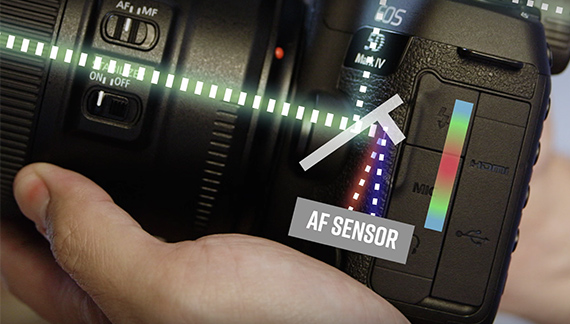It’s easy to take auto-focus for granted. Frankly, it’s a bit difficult to imagine how photographers of the past were able to get by without it. But as often as we take advantage of our cameras’ auto-focusing features, the majority of photographers lack an understanding of how, exactly, the technology works:
As photographer David Flores from B&H explains, there’s more than one way to auto-focus. What’s more, understanding the functional differences between the two main detection systems can actually improve the quality of your photographs.
Phase Detection
How It Works
When light passes through an SLR lens, an internal mirror reflects images up and through a pentaprism, which allows us to see through our viewfinders. With phase detection auto-focus, some of the light reflecting off a scene passes through the primary mirror to a smaller sub-mirror. That additional mirror then divides the incoming light into two separate beams and bounces them downward. A sensor toward the bottom of the camera can then calculate a subject’s distance based on where the light beams fall. The sensor then triggers a motor that controls the focus of the lens.
The technology used by each of the major camera brands differs slightly, but conceptually the process remains the same across the board.

When to Use It
Phase detection AF works significantly faster than contrast detecting autofocusing systems. Sports, wildlife, or any subjects in motion come out a little bit clearer and crisper when phase AF is employed. It is important, however, to keep in mind that phase-detection systems can fall out of alignment and work differently between lenses. Before you get out in the field, you may need to find the time to fine-tune your camera’s focusing system.
Contrast Detection
How It Works
Unlike phase detection AF, contrast detection systems analyze any and all points of contrast being picked up by the camera’s sensor, pixel by pixel. By pushing focus back and forth, the camera is able to calculate the highest points of contrast within a frame. Though that may seem a little time consuming compared to the immediacy of phase detection, contrast detection AF is extremely accurate, making it a desirable feature for many photographers.
When to Use It
The time that contrast detection takes to calibrate can mean missing out on an opportune moment with a fast-moving subject. However, it can really benefit portraiture, landscapes, and still photographs of all genres. In addition to providing increased focal accuracy, contrast detection AF offers a larger array of potential focal points.

Each system has its own set of pros and cons dictated by its technology. Neither system outranks the other. In fact, the two complement one another quite well. For this reason, many cutting edge cameras offer phase and contrast focusing options to accomplish the task at hand.
Using AF makes the life of every photographer a little bit easier. Knowing how to apply AF functionalities doesn’t just make things easier, it makes us more effective image makers, as well.
“Autofocus systems make a huge difference in the way your camera and lenses perform from subject to subject.”
For further training: The DSLR Crash Course at 52% Off
Go to full article: Auto Focus: Phase vs. Contrast Detection
What are your thoughts on this article? Join the discussion on Facebook
PictureCorrect subscribers can also learn more today with our #1 bestseller: The Photography Tutorial eBook
The post Auto Focus: Phase vs. Contrast Detection appeared first on PictureCorrect.
from PictureCorrect https://ift.tt/2NzsUbV
via IFTTT






0 kommenttia:
Lähetä kommentti